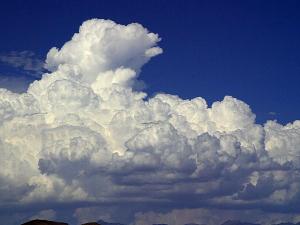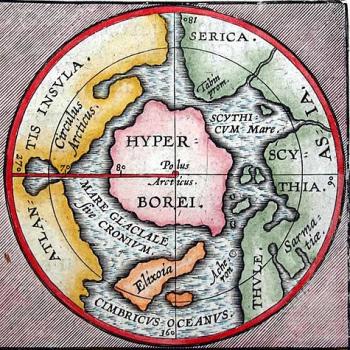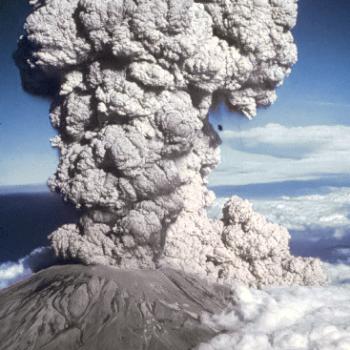
It’s hard to find a more important moment in Earth’s history than the very first thunderstorm.
For 700 million years after the planet formed, the volcanic landscape was too hot for water to exist in any form until finally the crust began to cool and high in the atmosphere the temperature dropped below 100 degrees Celsius for the first time.
At that moment – about 3.8 billion years ago – water vapor condensed into clouds for the first time and it didn’t stop raining for about 300 million years, maybe longer.
It wasn’t until Gottfried Wilhelm von Leibniz published Protogaea in 1680 that modern science recognized the earth was once a glowing mass of molten lava, and that the first extended thunderstorm created the oceans.
“[The Earth was] originally a burning luminous mass, which ever since its creation has been undergoing refrigeration,” wrote Liebniz. “When the outer crust had cooled down sufficiently to allow the vapors to be condensed, they fell, and formed a universal ocean …”
Science v. Religion
For centuries the Vatican tried to co-opt Liebniz’ theory as proof of Noah’s Flood and actively railed against geologists who found clear evidence of a world much older than the 6,000 years suggested in the Bible. Just 60 years ago, at least one scholar still found it necessary to push back on the church.
In 1969, Time-Life published The Sea, including the following observation on how the oceans were formed. “The accumulation [of the seas] did not take place through ‘the greatest deluge of all time’ that has so often been described. So far as anyone can tell, it may merely have rained as it rains today. Nature has plenty of time. It probably took a billion years to fill the oceans.”
Today the Duke University website delivers the straight story; “The water on Earth stayed in gaseous form until the planet’s surface cooled below 100 degrees Celsius. At this time, 3.8 billion years ago, water condensed into rain and poured onto the land. Water collected in low lying areas which gradually became the primitive oceans.”
The science of ancient myth

Long before western science fought to make the case for a molten earth that cooled enough to form clouds, myths from indigenous cultures around the world identified cloud formation as the moment of creation.
It seems the condescending nature of most Christian scholars prevented them from entertaining the notion that indigenous people understood the workings of the planetary water cycle. Perhaps the haughtiest of all was Herbert Spencer, who wrote in The Principles of Sociology Volume I (1874) that “savages” had no idea from where clouds came.
“In the sky, clear a few moments ago, the savage sees a fragment of cloud which grows while he gazes. … Something he could not before see has become visible … The whence, and the where, and the why, he cannot tell; but there is the fact,” Spencer wrote.
In contrast, a quick tour through just four creation myths shows a keen understanding that heat plus water equals clouds. The Kuba of Central Africa say clouds formed after the creator vomited the sun onto the primordial ocean, the supreme being of the Tungus in Siberia set fire to the ocean and evaporated the world-covering waters, the Sulawesi of Indonesia say a hot rock emerged from the primordial sea to form clouds and the Pawnee of the Great Plains describe Morning Star throwing a fireball at a serpent representing the primordial ocean.
The first thunderstorms
Other creation stories describe the first clouds and storms filling the oceans, including the West African Yorubans of West Africa, whose creator god Oludumare gathered invisible vapors to form clouds and create the ocean.
Early Hindu texts say that from primordial nothingness came a desire, “Let me be,” and from this came fire and smoke, ultimately producing clouds and rain and filling the oceans. In a similar myth from the American southwest, the Zuni Pueblo say the first thought of the creator Awonawilona radiated outwards as mist, forming great thickening clouds and storms that filled the seas. The Chewa of Malawi in West Africa believe the creator Chiuta lived in the sky until one day clouds formed into a thunderstorm. The first people, animals and vegetation appeared out of the rain.
It’s worth noting that water, in one form or another, was already present at the beginning of all creation stories. No creator god is given credit for creating water. It is the ultimate divine substance. Even the Judeo-Christian god in the Book of Genesis does not create the waters, but merely “separates” them into ocean and clouds.
Creating the landscape
Unlike the catastrophic Sumerian and Judeo-Christian flood stories, many ancient and/or indigenous cultures perceived the original storm and flood as benevolent in nature, shaping the mountains and valleys and providing opportunities for life in all its forms to find food and shelter.
The Yorubans conceived of an original storm whipped up by angelic beings after creation, transforming what had been a completely level earth into a diverse landscape of mountains and valleys. The Bunun of Taiwan say a flood came after a fight between a snake and a crab, transforming a previously flat land into mountains and valleys.
For Aboriginal cave painters in Kimberley, Australia, the Wandjina were human-like creator spirits of clouds and rain that rose from the sea like mist and came down from the sky like rain and shaped the earth’s topography. The Nlakapamuk of British Columbia described a great flood receding to form the terraces of mountains while leaving fish behind in lakes and creeks.
The moment of creation
Across dozens of cultures the moment of creation was defined as when the planetary water cycle began, when heat was introduced to the dormant primordial waters, producing clouds and storms that rained down and flooded the landscape.
Some ancient and indigenous cultures took it a step further and conflated rain with the seeds of vegetation. The 20th century historian Mircea Eliade wrote that the Pima tribe of New Mexico believed mother earth was made pregnant by a drop of water from a cloud, and observed that the Sumerian word “a” meant both water and sperm.
A key to early conceptions of the water cycle is its immortality. Once a creator god started the cycle it couldn’t be stopped. For example the water cycle is an endless manifestation of Dao in The Annals of Lu Buwei (2000, Stanford University Press), a compendium of knowledge written about 2,300 years ago.
“Clouds and vapors move to the west in great abundance, stopping neither in winter nor in summer; rivers and streams flow to the east resting neither day nor night … these are examples of the circularity of the Dao.”

Academic blindness?
The archaic belief in water as a divine substance is described by early western anthropologists and other scholars, including Edward Burnett Tylor, Andrew Lang, Herbert Spencer, George Frazer, Rudolf Otto and Gerardus Van Der Leeuw.
The most extensive exploration of the subject is found in Eliade’s numerous books, yet even he did not explore the indigenous perception of the planetary water cycle as a whole, and as a never ending series of morphing phases.
But the catalyzing of a perpetual water cycle is consistent with Eliade’s observation that indigenous creator gods often leave the scene soon after the fact, a concept he called Deus otiosus. It’s the mythical sons and daughters of the creator, in the form of wind, weather and storms, that were the pressing concern. Only in extreme emergencies was the creator called upon.
It’s no surprise that mastery of the waters was the calling card of the shaman(ess), who was believed capable of traveling to the heavens by shape-shifting along with the water cycle. A performative shamanic journey might include dramatic moments like the rescue of a wandering soul but after the spirit-adventure was over the audience would always be rewarded with predictions of coming weather.
Embedded truths
Myths of creation are often filled with fantastical characters, surrealistic plot-lines and supernatural magic. There are cosmic giants, primordial serpents and naked goddesses dancing on the waters, not to mention fireballs, mountains arguing over who was taller and creative thought-waves.
To modern ears these are bizarre and fantastical, but were inserted largely to meet the hyperbolic requirements of oral storytelling. Embedded in those characters and plot-lines was the knowledge that our planetary water cycle had a start date and was responsible for filling the oceans.
It’s hard to escape the conclusion that reaching the same scientific understanding in the western world was an uphill battle over several centuries against the Judeo-Christian tradition, which favored its appropriation of the cloud as an iconic symbol of the creator god rather than accept the truth and beauty of the cloud’s natural and scientific origins.
(Ben H. Gagnon is the author of Church of Birds: An Eco-History of Myth and Religion, to be released March 31, 2023, by John Hunt Publishing, London, now available for pre-order. More information on the book is at churchofbirds.godaddysites.com, which links to a YouTube video on some of the larger themes in the book. The material in this column does not appear in the book.)
















